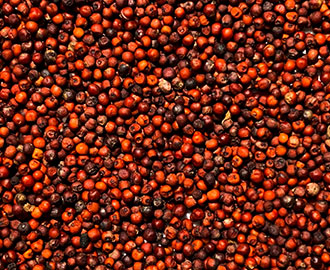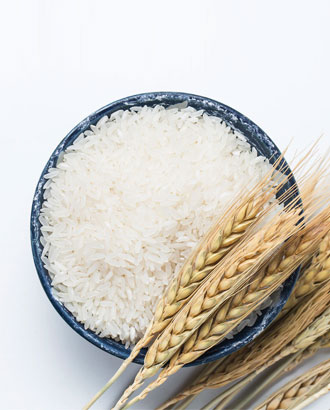Pulses & Grains
Nearly every cuisine has its own variation of “rice and beans” or “whole grains and pulses.” Pulses (the food group that includes beans, peas, lentils, and chickpeas) are natural partners for whole grains from both a culinary and a nutrition science perspective.
Pulses differ from whole grains in their structural and physicochemical properties and have varying amounts of fibre, resistant starch, vitamins, minerals, and other bioactive components; nevertheless, these food groups complement each other.
The major states producing pulses in India are Madhya Pradesh, Rajasthan, Maharashtra, Karnataka and Andhra Pradesh.Moreover, India is the largest pulses processor, as pulses exporting nations such as Myanmar, Canada and Australia.
Rice
Rice has shaped the culture, diets and economic of thousand of millions of peoples. For more than half of the humanity “rice is life”. Considering its importance position, the United Nation designated year 2004 as the “International Year of Rice". Importance of rice are as follows:
a. Rice is an important staple food crop for more than 60% of the world population. In 2008, more than 430 million metric tons of rice were consumed worldwide, according to the USDA.
b. Ready to eat products eg. popped and puffed rice, instant or rice flakes, canned rice and fermented products are produced
c. Rice straw is used as cattle feed, used for thatching roof and in cottage industry for preparation of hats, mats, ropes, sound absorbing , straw board and used as litter material.
d. Rice husk is used as animal feed, for paper making and as fuel source.
e. Rice bran is used in cattle and poultry feed, defatted bran, which is rich in protein, can be used in the preparation of biscuits and as cattle feed.
f. Rice bran oil is used in soap industry. Refined oil can be used as a cooling medium like cotton seed oil / corn oil. Rice bran wax, a byproduct of rice bran oil is used in industries.
In India, rice is fundamentally situated in states like Uttar Pradesh, West Bengal, Andhra Pradesh, Tamil Nadu, Punjab, Orissa, Chhattisgarh and Bihar. These biggest rice producing states hold around 72% of India’s absolute rice producing region and offer over 75% of the all-out rice production in the country.
India is the world's second-largest producer of rice, and the largest exporter of rice in the World Production increased from 53.6 million tons in FY 1980 to 120 million tons in FY2020-22
Basmati is a variety of long, slender-grained aromatic rice which is traditionally grown in India.Basmati grains contain about 0.09 ppm of this aromatic chemical compound naturally, a level that is about 12 times as much as non-basmati rice varieties, giving basmati its distinctive fragrance and flavour. This natural aroma is also found in cheese, fruit and other cereals. It is a flavouring agent approved in the United States and Europe, and is used in bakery products for aroma. India accounts for over 70% of the world's basmati rice production. The areas which have for basmati rice production in India are in the states of Punjab, Haryana, Himachal Pradesh, Delhi, Uttara hand, Western Uttar Pradesh and Jammu and Kashmir.Saudi Arabia, Iran and UAE were the three biggest destinations for India's basmati rice exports and exports to these three countries accounted for more than half of India's total basmati exports.
- 1121 Basmati Rice
- 1509 Basmati Rice
Both Available Grades: Sella, golden, steam and raw
Non- basmati rice comes in all kinds of different shapes and sizes. Some are long and slender, some are short and thick, some are like beads, and some may be round. None have the same characteristics as basmati rice. Some names of non-basmati rice are shaped like basmati rice and PR, 104 IR8, IR 64, Masuri.It is lighter and fluffier after cooking, while non-basmati rice comes in every unique form and sizes-long, thin, short, thick, beads, and round.In the world it has been reported that there are 10000 varieties of rice and out of which the maximum number are in India.The country has exported 1,30,95,130.21 MT of Non-Basmati Rice to the world for the worth of Rs. 35,476.61 Crores/4,799.91 USD Millions during the year 2020-21.
- Sona Mansuri Rice
- Broken Rice
- Ponni Rice
- Swarna Rice
- IR 64 Rice
- Matta Rice
- GR 11
| Origin | India | Port | All Over India |
| Packaging / Labeling | As Per Customer Request | Specification | Detailed Specification on Request Send Request |
Red Millet
Red Millets are one of the oldest foods known to humans. They are highly nutritious, non-glutinous and not acid forming foods. Hence they are soothing and easy to digest. They are considered to be the least allergenic and most digestible grains available. They are particularly high in minerals like iron, magnesium, phosphorus and potassium. Red millet (Ragi) is the richest in calcium content, about 10 times that of rice or wheat.
India is the world leader in the production of millets with a share of around 45% of total world production in 2021. India produces around 14 million MT of millets annually, the top three importers of millets from India in 2020-21 were Nepal (USD 6.09 million), UAE (USD 4.84 million) and Saudi Arabia (USD 3.84 million). The other seven destinations in the top-ten list of India's millet export are Libya, Tunisia, Morocco, UK, Yemen, Oman and Algeria.
| Origin | India | Port | Chennai, Tuticorin, Nhavasheva |
| Packaging / Labeling | As Per Customer Request | Specification | Detailed Specification on Request Send Request |


Horsegram
Horse gram is a legume native to tropical southern Asia, known for its distinct taste and texture, widely used legume in many cuisines. It's also known for its impressive nutrient profile and medicinal properties.Horse gram is loaded with fibre and protein, two important nutrients that play a key role in weight management.
Horse gram is grown in Andhra Pradesh, Bihar, Chhattisgarh, Himachal Pradesh, Jharkhand, Karnataka, Madhya Pradesh, Maharashtra, Orissa, Tamil Nadu, Telangana, Uttara hand, Jammu and Kashmir, and West Bengal in India. India exports most of its Horse gram to The United States, Sri Lanka and Singapore.
| Origin | India | Port | Nhavasheva, Mundra |
| Packaging / Labeling | As Per Customer Request | Specification | Detailed Specification on Request Send Request |
Chick Peas (Chana Dal)
India is the world's largest producer of chickpeas popularly available as two varieties of "Kabuli" and "Desi". India accounts for 70 percent of the world's total production of chickpeas. Chickpeas are known for their nutty taste and rich protein content.
We L&J FOODS IMPEX PVT LTD offered Chickpeas that are even stringently inspected so as to ensure their natural taste and colour stay intact. Our Chickpeas are widely appreciated among customers for their outstanding features like unique flavour, purity, natural colour and longer shelf life.
Sizes
- 12MM – 13 MM (40/42 COUNT)
- 12 MM (42/44 COUNT)
- 9 MM (58/60 COUNT)
- 8 MM (75/80 COUNT)
| Origin | India | Port | Nhavasheva, Mundra |
| Packaging / Labeling | As Per Customer Request | Specification | Detailed Specification on Request Send Request |





